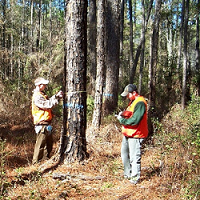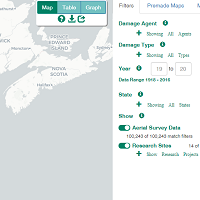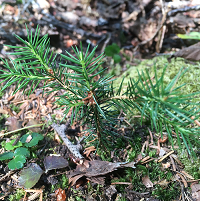On top of the database work of the FEMC, our collaborations and partnerships have lead to the development of environmental monitoring and data access tools that allow the everyday user to interact with and acquire data in new and customized ways.
Tools
Continuous Forest Inventory Program Comparison Tool
FEMC is working with partners across the region to assemble and compare continuous forest inventory (CFI) monitoring and assessment programs. The goal is to identify commonalities and differences in the various datasets, document the ways in which they can be compared, and enable broad-scale analyses across states. FEMC will make available protocols, data samples, access instructions and data downloads when possible in an online data portal. With funding provided by the USDA AFRI program, we are collaborating with researchers from UVM and UMaine to combine these data in meaningful and statistically robust ways so that we can answer relevant and timely questions concerning the status of regeneration in the region.
Read the final report for the first phase of this project.
The program comparison tool was released in June 2020. Work on further data integration is ongoing.
Data Rescue
A wealth of monitoring, inventory, and research data exists that is currently inaccessible to the broader community, ranging from data sheets stored in file cabinets to electronic files on a person’s hard drive who doesn’t have the time or resources to archive those data. In these cases, data are at risk of being lost to natural disasters and retirements. FEMC alleviated some of this risk by engaging with natural resource agencies in the region to inventory data at risk of being lost. We rescued dozens of new long-term high-value monitoring and research datasets, uploading each to the FEMC archive to be preserved in perpetuity and available to the broader community. View the full list of at-risk data or submit your own at-risk project using the Data Rescue Inventory (https://www.uvm.edu/femc/data_rescue).
This effort was initiated in May, 2019, and the Data Rescue inventory is updated as we hear from you about more projects to include.
FragNet: The Northeast Forest Fragmentation Information Network
The Northeast Fragmentation Information Network (FragNet) is a clearinghouse containing a wealth of various resources about forest fragmentation - the breaking up of continuous forest cover. These resources have been collected from throughout the northeastern US to make it easier for policy makers, planners, advocates and researchers to access information on forest fragmentation. Using FragNet, you can explore resources such as journal articles, technical reports, brochures and legislation.
This tool was first released in October, 2018, and is updated with new resources annually.
Meteorological Data Live Feed - Vermont Locations
FEMC maintains several meteorological stations on Lake Champlain and the slopes of Mt. Mansfield. You can use this tool to view the latest data as soon as we collect it. Please note that data are not subjected to QA/QC procedures, and are provided as-is with no guarantees.
NEFHA: Northeast Forest Health Atlas
The Northeastern Forest Health Atlas (NEFHA) is a web portal for forest health data that provides information on short- and long-term changes in forest health and disturbance for researchers, managers, policy makers, and the public. The mapping platform brings together research and monitoring data on forest damage and disturbance in the Northeast. The user-interface allows for easy searching of biotic and abiotic damage agents, by state, or year, and can be viewed as a map of detections, or in a graph or table format.
This tool was first released in September, 2018.
Want to learn more about the Northeastern Forest Health Atlas? Click here to view a webinar from September 2018 on how NEFHA works.
NEFIN: The Northeastern Forest Inventory Network
The Northeastern Forest Inventory Network is designed to connect people, data and information related to forest inventory programs across the Northeast. This project aggregates data from a diverse and disconnected network of sources that can be used for novel synthesis and analysis of factors influencing forest structure, productivity and health. The research conducted with these data will provide new insights on how forests are growing and changing across the region, improve our understanding of forest demography and biometry, and inform forest management.
Oak Resiliency Assessment Tool
The Oak Resiliency Assessment Tool allows you to consider how resilient oak-dominated forest stands on your property or a property you manage are to climate change and various stressors. The tool will generate a report with the forest's vulnerability and more information regarding the major forest stressors and potential management actions. You can use this report to inform your management decisions and include it in the property's forest management plan. The assessment is designed to be used at a stand level and may work for a small property or parcel.
REGEN: The Northeast Forest Regeneration Data Network
The Forest Ecosystem Monitoring Cooperative created the Northeast Forest Regeneration Data Network for users to access and compare projects related to tree regeneration, including studies on browse impacts, seed production, and forest management.
Through the interactive website, projects can be filtered by selecting which metrics a user is most interested in (like seedling species data), along with other project parameters, like location, timeframe, and number of repeat inventories. Users can then browse and explore individual projects, access structured metadata, download methods, view or download data (when available) and view the relative suitability of each project for a range of analyses.
Visit the project page to learn more about the project and access the report.
This tool was launched in July, 2020.
Vermont Forest Indicators Dashboard
The Vermont Forest Indicators Dashboard is a data-driven, ecological monitoring tool that quantifies the condition of Vermont's forested ecosystems in simple terms that offers a more holistic view of the structure, function, and services the forests provide. Current conditions and long-term trends can be compared to threshold or baseline values to help inform management and decision making to sustain this critical resource. The dashboard currently summarizes information about 34 different long-term datasets, from timber production to crown condition to regeneration trends to forest bird diversity.
Each indicator is given:
- an annual score
- a comparison to long-term trends
- a chart with trend line
- a contributing weight towards the overall score of the category
Want to learn more about the Vermont Indicators Dashboard? Click here to view a webinar from August 2018 on how the Dashboard works.
This tool was released in August, 2018, and each indicator is examined annually for new datasets that are released








